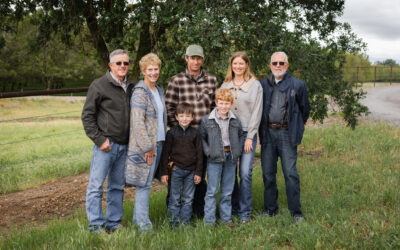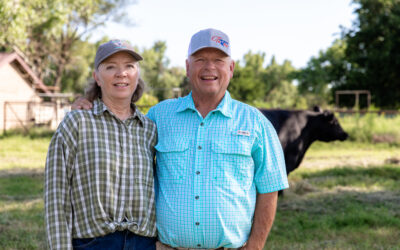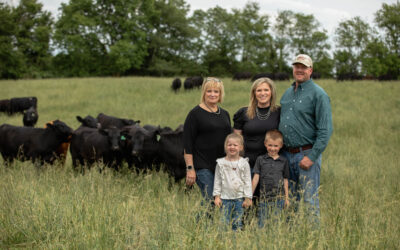
HISTORY, DATA AND HARD WORK
Joe and MaryAnn were married in July of 1971, and after receiving his degree from Oklahoma Panhandle State University, assumed co-management along with his father, of the family’s operation. For 100 years, the ranch consisted of commercial Hereford cows, bred to Hereford bulls, but eventually became a commercial Angus operation, beginning that transition in the mid- to late 1970s.
As a teenager, Joe calved out about 400 head of Hereford cows, “and I pulled 399 of them” he states, facetiously. “Well, maybe about 60% of them,” he finishes. After that debacle, they switched to Angus bulls for a black-baldie calf in the mid-1970s.
“Right away, we cut our calf pulls down to about 30%”, he says, “but that was still too many. We didn’t have EPDs in those days to help us select for calving ease, but it was a big improvement.” But, back then, black-baldie calves were discounted at the salebarn, compared with a straight Hereford calf.
The ranch experimented with Charolais in the mid 1950s, but conception rates were very low. Not a fault of the breed, rather, they were using artificial insemination, and they didn’t have good luck. The few that did conceive disappeared over time. Then came the Limousin bulls, also during the 1970s. “Good cattle, terrible disposition,” he quips. Then followed with Gelbviehs. “Gelbviehs are great cattle; good disposition, growth, milk, fertility. But there’s no grade in those cattle, and when you hang ‘em up, they only went about 40% Choice.”

If a female produces a calf that grades USDA Select, she is out the gate and to the sale barn. Quality is paramount; all cattle are sold on the grid with the idea of not only providing the consumer with a high-quality product, but it also improves the bottom line.

Buying replacement heifers to rebuild the herd, Joe has employed GeneMax to test these females to aid in his culling protocol. He has purchased nearly 500 tests to date. Believing that DNA selection will eventually replace EPDs, the current DNA technology, he feels, has been important in improving the accuracy of time-honored EPDs in use today.
The couple have three children, and two are associated with the operation. Son Paul lives near Hardesty, Okla., and is directly involved with the ranch. Daughter Margie lives on the ranch and keeps the record books. Oldest daughter Katie lives in Evergreen, Colo., and is an attorney with degrees from Harvard.
I couldn’t think of a better way to spend time on the road, than visiting with good folks like this!
Until next time,
Gary
You may also like
Legacy in the Golden Land
On a quiet stretch of Northern California rangeland, a different story unfolds. The Borror family’s legacy modestly speaks through the cattle they raise, the ground they steward. The generations who’ve made a life here demonstrate commitment to doing things right, even when no one is watching.
Helping Hands, Helping Herds
“When I die, I want to come back as one of your cows,” murmurs a friend to Steve Zybach. Full to the brim from an alfalfa ration every day, bountiful fields of lovegrass stretched out across the Texas Panhandle—and owners who leave no ounce of cattle care up for question. The Zybachs’ motivation for this level of dedication to their Angus cattle is simply love.
An Ambassador for All
Joanie, with daughter Lindsey and her husband, Adam Hall, raise registered Angus cattle with two primary goals: producing high-quality seedstock that perform well in a wide variety of environments and ensuring end-user satisfaction. Those goals tie everything together, from promoting Angus to other producers to sharing their story with CAB partners and beef consumers.




